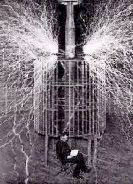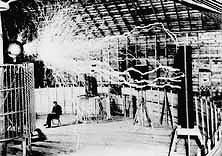The World Greatest Inventer
When asked who he felt was the world’s greatest inventor, science editor and publisher, Hugo Gernsback, said,
"If you mean the man who really invented, in other words, originated and discovered - not merely improved what had already been invented by others - then without a shade of doubt
Nikola Tesla is the world’s greatest inventor, not only at present but in all history...."
Nikola Tesla was born at midnight on July 9, 1856 in Smiljan, Lika, Croatia. He was known to say, "I am a Serb but my fatherland is Croatia." At the age of twenty-six while walking with a friend in a park in Budapest, Nikola recalled,
"…the idea occurred to me like a flash of lightning and in a second the truth revealed itself. With a stick I drew in the sand the diagrams...".
He was talking about an alternating current (AC) induction motor. Nikola patented his motor in 1893 and used it to light the World Columbian Exposition in Chicago in the same year. Then in 1896 the world’s first hydroelectric power was sent from Niagara Falls to light the city of Buffalo. Nikola Tesla, through George Westinghouse, had laid the foundations of the power system used around the world today.

Nikola in his lab
Many scientists and individuals acknowledge Tesla’s foresightedness and accredit him as being the originator of many of today’s inventions. The wording to describe Tesla’s 1891 carbon button lamp (the "brush"), with minimal word change, serves well as a description of the million-magnification point electron microscope developed by Vladimir R. Zworykin in 1939. The "brush" has also been related to the cyclotron and the atom smasher.
Tesla described a vacuum bulb, considered to be the forerunner of the radio vacuum tube. He talked about visible and invisible light and described blurred photographic plates in his laboratory, considered to be the earliest reference to X-rays. And did Nikola venture into plasma physics when he created a flame and described it as "burning without consuming material or even a chemical reaction"?
Fifty years before the development of the fluorescent lamp, Nikola built phosphor-coated globes and illuminated his gas-filled tubes, which he had twisted into names. The disputed credit for the invention of the radio was settled in 1943 when the U.S. Supreme Court reversed an initial finding in Marconi’s favor to rule that Tesla had anticipated all other contenders with his fundamental radio patents.
The list of credits given to
Nikola Tesla is large indeed. He has been associated with cosmic rays, radar, diathermy, the high-frequency furnace, wave-guide for microwave transmission, space navigation code, cryogenic engineering, electrotherapeutics, energy transmission to satellites, principles of solid state transistor technology, and the reciprocating dynamo.

Tesla’s genius with electricity received further stimulation through his interest in resonance. The ubiquitous Tesla Coil is evidence of the synergy of electricity and vibrations. With a power cord from an insulated handle at one end and primary and secondary coils tuned to resonate at the other end, the Tesla Coil, when plugged in, begins to vibrate and hum.
The small Tesla Coil generates high voltages and high frequencies and is used in one form or another in every radio and television set and can be found in every university science laboratory: used to detect leaks in vacuum apparatus.
It has been said that resonance is a manner in which nature works. It covers all aspects of science from electricity to nuclear fusion. Nothing exists in the Universe that does not have vibration. Nikola knew that vibration is the rapid back-and-forth motion of an object, which creates waves. He also knew that resonance is the effect of these waves on another object when, in 1898, he made an oscillator no larger than a fist and attached it to a steel link two feet long and two inches thick.
"For a long time nothing happened..." he said. "But at last ... the great steel link began to tremble, increased its trembling until it dilated and contracted like a beating heart - and finally broke!"
Though his genius was often ridiculed, his own comments showed his confidence.
"I know that you are a noble fellow and devoted friend and, noting your indignation at these uncalled-for attacks, I am afraid that you might give it expression. I beg you not to do it under any condition, as you would offend me. Let my ’friends’ do their worst, I like it better so. Let them spring on scientific societies worthless schemes, oppose a cause which is deserving, throw sand into the eyes of those who might see - they will reap their reward in time...."
In his younger years Nikola sensed the universe was,
"composed of a symphony of alternating currents with the harmonies played on a vast range of octaves. The 60-cycles-per-second AC was but a single note in a lower octave. In one of the higher octaves at a frequency of billions of cycles per second was visible light. To explore this whole range of electrical vibration between his low-frequency alternating current and light waves, he sensed, would bring him closer to an understanding of the cosmic symphony." (1)
In his sunset years, Tesla believed that all matter came from a primary substance, the luminiferous ether, which filled all space.
Nikola once said,
"...I continually experience an inexpressible satisfaction from the knowledge that my poly phase system is used throughout the world to lighten the burden of mankind and increase comfort…"
Amongst his many legacies to society are a number of small items that employ Nikola’s discoveries in both electricity and vibration. Nikola influenced the production of personal oscillators that vibrate in tune with "the luminiferous ether" (collectively called, Purple Plates). Like many of his inventions, the plates cannot be explained, and yet for over twenty-eight years the plates have continued to offer the same "increase comfort and happiness" to society that his poly phase system has provided since 1896.
Nikola Tesla, aged 86, died from coronary thrombosis at 10:30 PM on January 7, 1943 in his room at the Hotel New Yorker.


























 Tesla’s genius with electricity received further stimulation through his interest in resonance. The ubiquitous Tesla Coil is evidence of the synergy of electricity and vibrations. With a power cord from an insulated handle at one end and primary and secondary coils tuned to resonate at the other end, the Tesla Coil, when plugged in, begins to vibrate and hum.
Tesla’s genius with electricity received further stimulation through his interest in resonance. The ubiquitous Tesla Coil is evidence of the synergy of electricity and vibrations. With a power cord from an insulated handle at one end and primary and secondary coils tuned to resonate at the other end, the Tesla Coil, when plugged in, begins to vibrate and hum.














